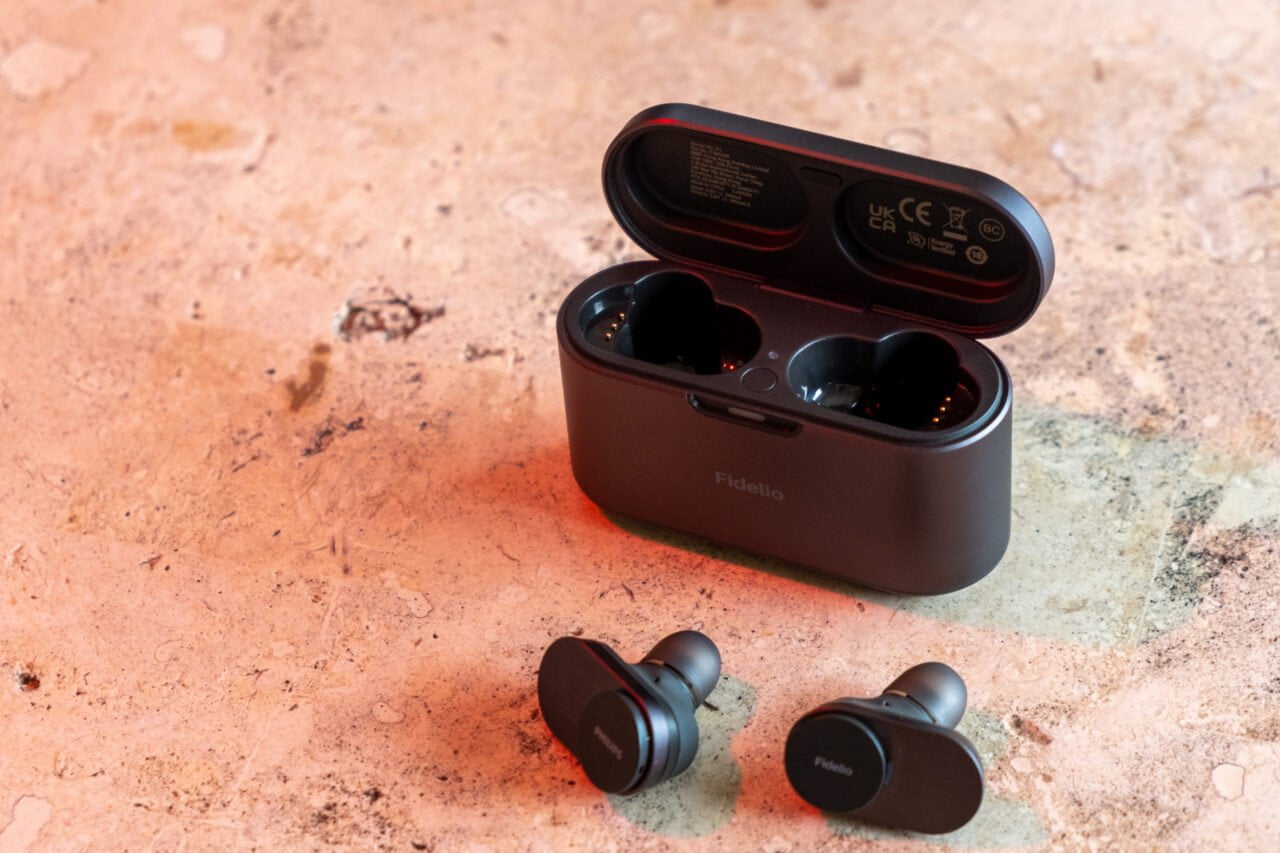Philips Fidelio T1 review in three sentences
- Sound quality
- Microphone and ANC
- Production quality
- Gestures and operation
- Battery
- App
Summary
Philips Fidelio T1 are really great-sounding and well-made headphones. They sound a bit different than most TWS headphones, but that’s a very good feature. However, they are cruelly large and will not fit everyone’s ear.
Benefits
- Sound quality at a very high level
- LDAC support
- Great workmanship
- Pretty easy operation
- Decent ANC and microphones
Disadvantages
- The app is only suitable for updating your headphones
- Very few gestures
- Extra large headphones and a case
Review of Philips Fidelio T1, the latest TWS headphones from a Dutch company. They are great as always, great looking, but what do they sound like, do they have good ANC and are they comfortable to use? All these questions will be answered by this review of the Philips Fidelio T1.
Contents
Set and price
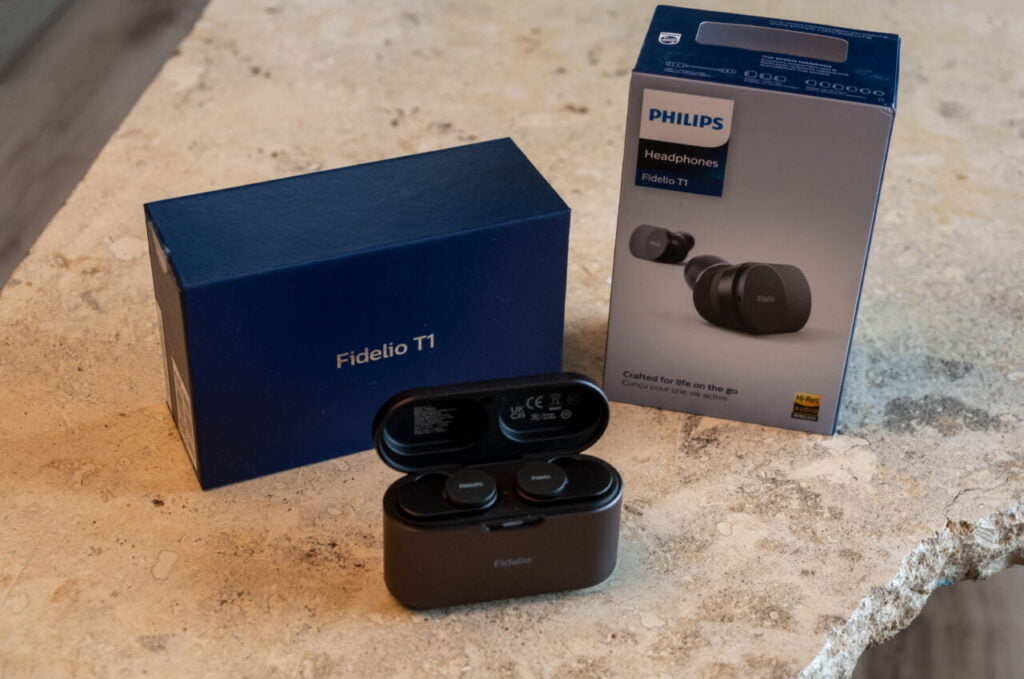
The reviewed Philips Fidelio T1 headphones come to us in a small box in a style that is quite market-oriented, but typical for the manufacturer. The inner box is relatively hard to slide out. I was struggling with it for a few minutes, because the whole thing was sucked up strongly.
However, when I managed to open it, I saw a nice set. Inside you will find a very rich set of tips, which, apart from as many as six pairs of silicone tips, also includes three pairs of Comply foams . You can read about them briefly in the in -ear ranking guide . Of course, inside there are also headphones with a charging case and a short charging cable.
The Philips Fidelio T1, which are the subject of the reviews, currently costs about USD $216.
Check the price of Philips Fidelio T1
Philips Fidelio T1 review – headphones specification
- In-ear wireless headphones
- Support for SBC, AAC, LDAC codecs
- Battery up to 13 hours without ANC (additional 35 with case), or up to 9 hours with ANC (additional 25 with case)
- Charging case for an additional four headphone charges
- Bluetooth 5.0
- USB-C for charging
Construction and build quality
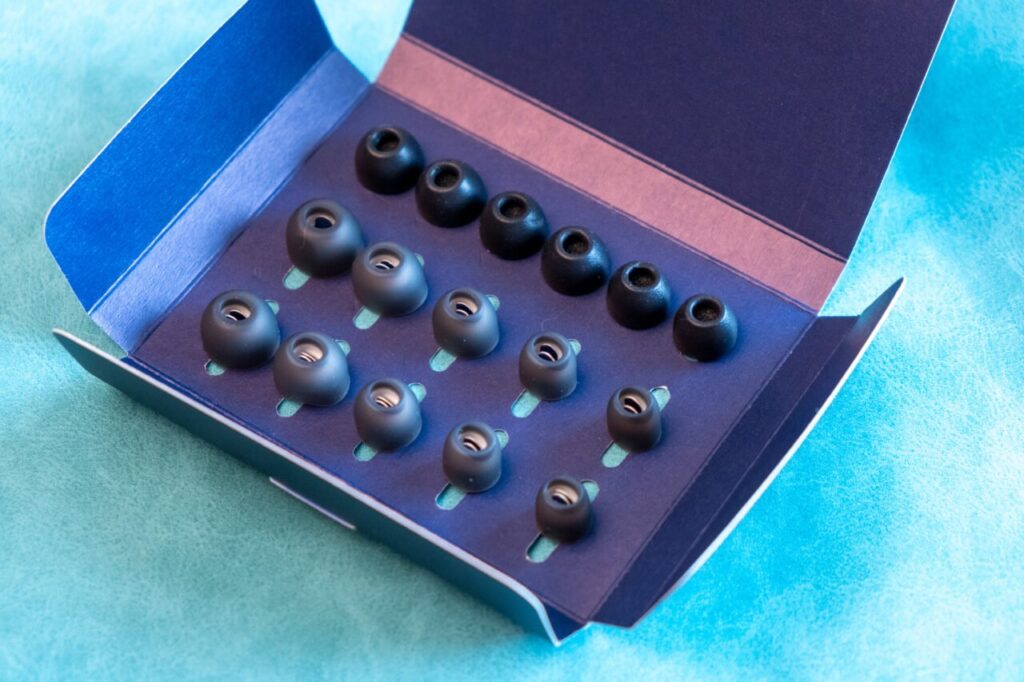
Let me start with the charging case as it is quite unusual. Recently, many manufacturers have opted for a smaller, fairly flat case, or in the shape of a small cube. The reviewed Philips Fidelio T1 differ from that, because the case is relatively large and thick. It is very noticeable in the pocket, which can irritate many people. The upper part of the case is closer to the standard because it opens to the back. There is also a leather strap with the manufacturer’s logo embossed on it. The whole thing is flawlessly made and really gives a premium impression.
The construction of the headphones is quite unusual
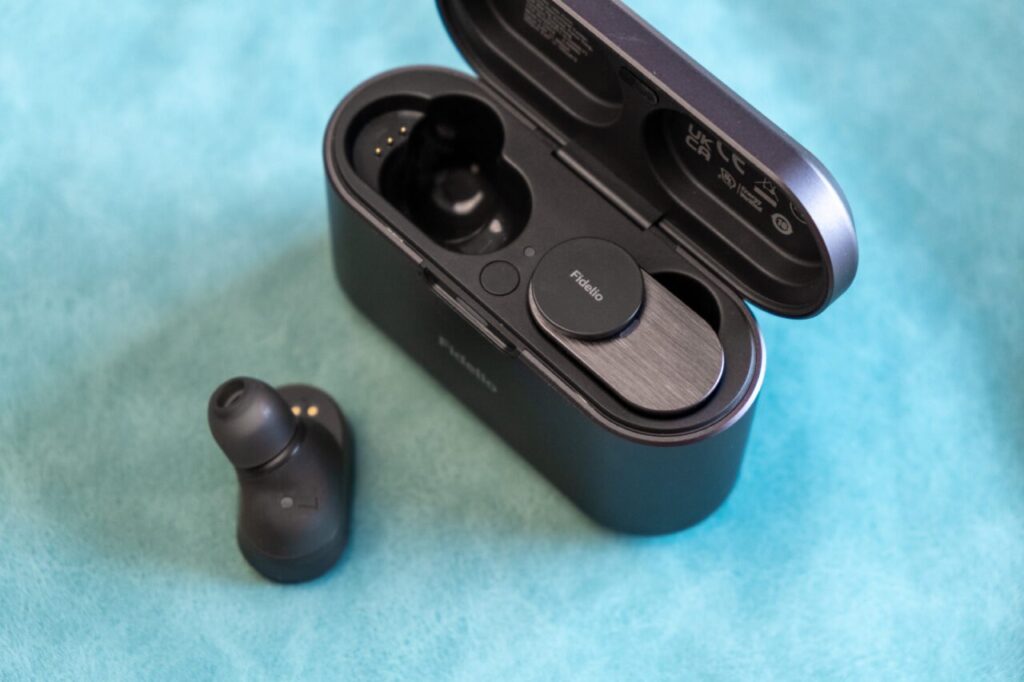
The Philips Fidelio T1 from the outside is made of brushed aluminum, and it has a wheel with a touch panel, which looks a bit futuristic in combination with the LED diode located next to it. The inner part is quite thick, covered with rubber. The sleeve, on the other hand, is made of plastic, oval-shaped, and the nail tips sit very tightly on it. The headphones are made very well, but they are quite heavy and simply too big.
Removing and putting on the headphones is a pain
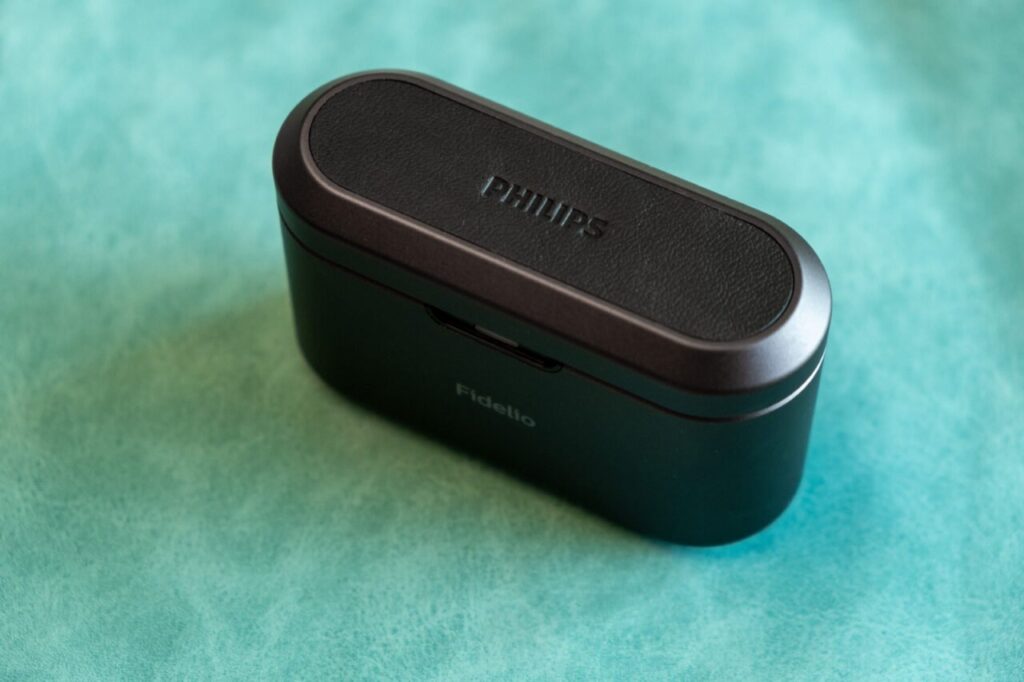
It is a pity that the manufacturer did not use a blocking hinge, because often between removing the first and second earphones, the case closes, forcing it to reopen. It also does not allow you to easily remove them when walking, because the case will keep bumping against your fingers. It’s also best to change the hand holding the case when removing the headphones, because there is no chance to comfortably place the left earbud in your ear with your right hand. Philips Fidelio T1 are also not grateful when taking them off, because the problems are the same as when putting them on.
Convenience, comfort of use and gestures
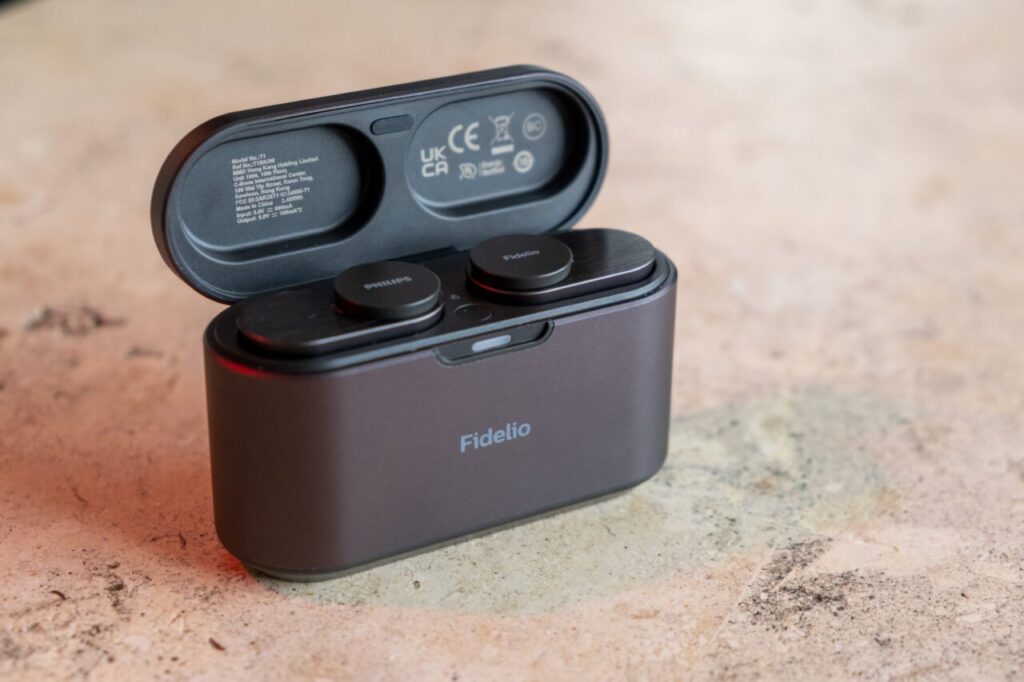
The reviewed Philips Fidelio T1 support gestures with the help of a touch panel. The very operation of the panels is almost perfect. They always pick up touch, never miss a touch, and don’t detect extra touches. But it is completely incomprehensible to me how they were set as a base .
A second tap is a pause, a double tap is ANC on and off and ambient listening mode, and a triple click is the next song. It is not possible to play the previous track with gestures. In my opinion, however, it should be set in a different way, because it is simply unintuitive and not very comfortable, especially if we are used to handling other TWS headphones.
Unusual shape of tips and headphones
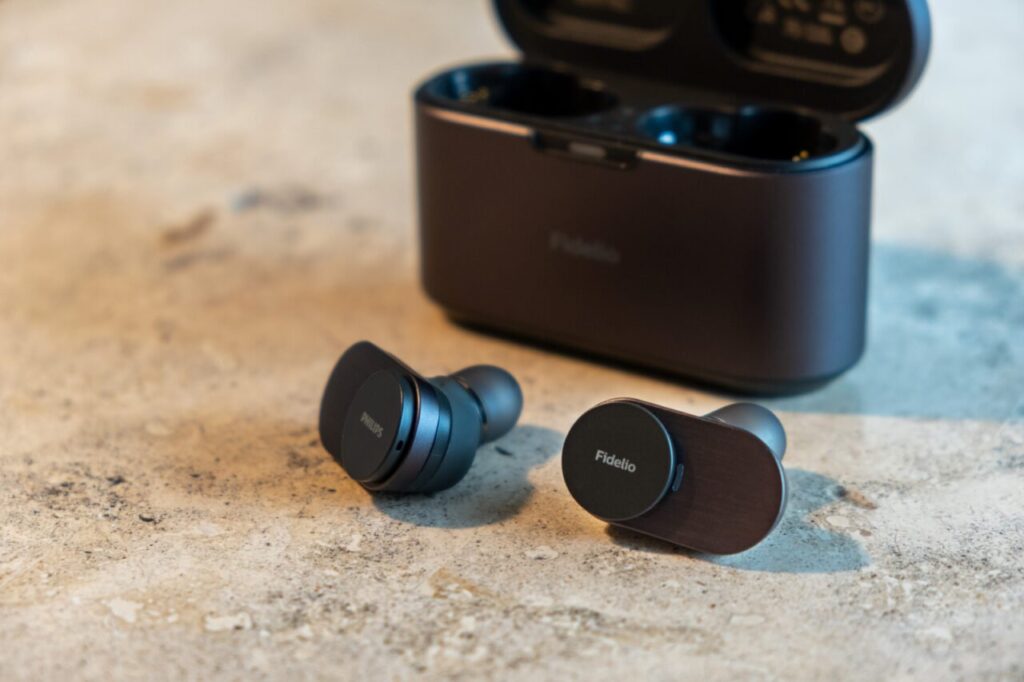
The shape of the tips used in the Philips Fidelio T1 TWS headphones suggests that the headphones should enter the ear canal quite deeply. In my case, however, it is impossible to achieve due to the large base part of the headphones. They slide out very easily from my small ears. The upper part of the headphones, with the touch panel on it, is slightly too long, which makes it impossible to lean against the auricle.
Due to the shallow placement of the headphones in the ears, they also fall out easily when talking or eating. Comply foams are less likely to do so, but not everyone has to be a fan of them either. In my case, it significantly increased the comfort and reduced the chances of the headphones falling out of my ears.
On the other hand, they detect very well whether they are in the ears and whether we speak
I complained about this aspect gently in the case of the bigger brothers, the Philips Fidelio L3 . In the canal model, however, it is much better, because the headphones immediately know that they have been removed from the ear and you need to put your hand very close to the sensor for the music to start playing again. However, not once did I have a problem that I put the earpiece back in my ear and the music does not play, which I consider to be a very big plus. The headphones also have the function of playing our voice during conversations, which greatly helps when making phone calls or during videoconferences.
The quality of the microphones is decent
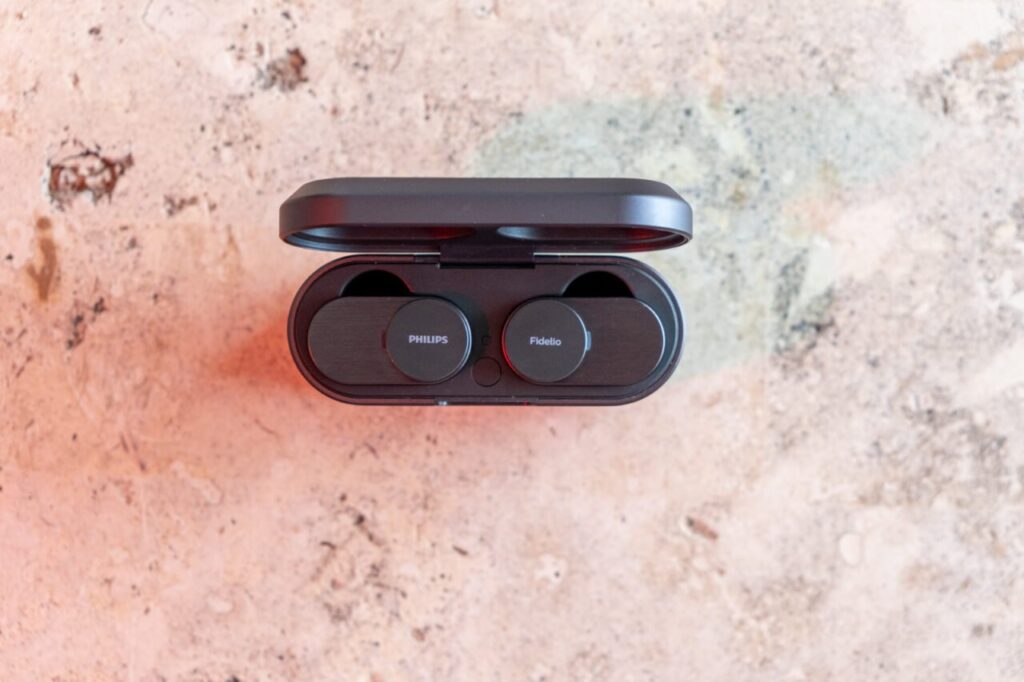
The Philips Fidelio T1, which are the subject of this review, are quite good for phone calls, although you also feel that this was not the main aspect that guided them at Philips. In a quiet apartment or outside, where it is windy, they do great. The voice is natural, and none of the three microphones pick up on the sounds of the wind. However, it is a bit worse when it comes to conversations in a noisy environment, where our voice sometimes becomes a bit louder, and then much quieter again, which makes it difficult for the interlocutor to understand what we want to convey.
ANC has better and worse moments
But you can hear that Philips is trying to improve this feature with the next updates. Basically, the reviewed Philips Fidelio T1 did not impress ANC. The noise of electronics was often at the level of background noise, and in the case of sudden sounds and conversations, the headphones did not significantly affect their volume.
After updating them with the Philips Headphones app, I heard a significant improvement. The noise of the electronics has decreased significantly, and the headphones have started to better cancel out a lot of background noise. They deal very well with the uniform hum of air conditioning or the subway, but they also significantly reduce voices and keyboard clicking. The only thing that remains intact are the very high tones, like the screeching of brakes on a tram , or the screams of some children in the playgrounds.
The connection quality is amazing for LDAC
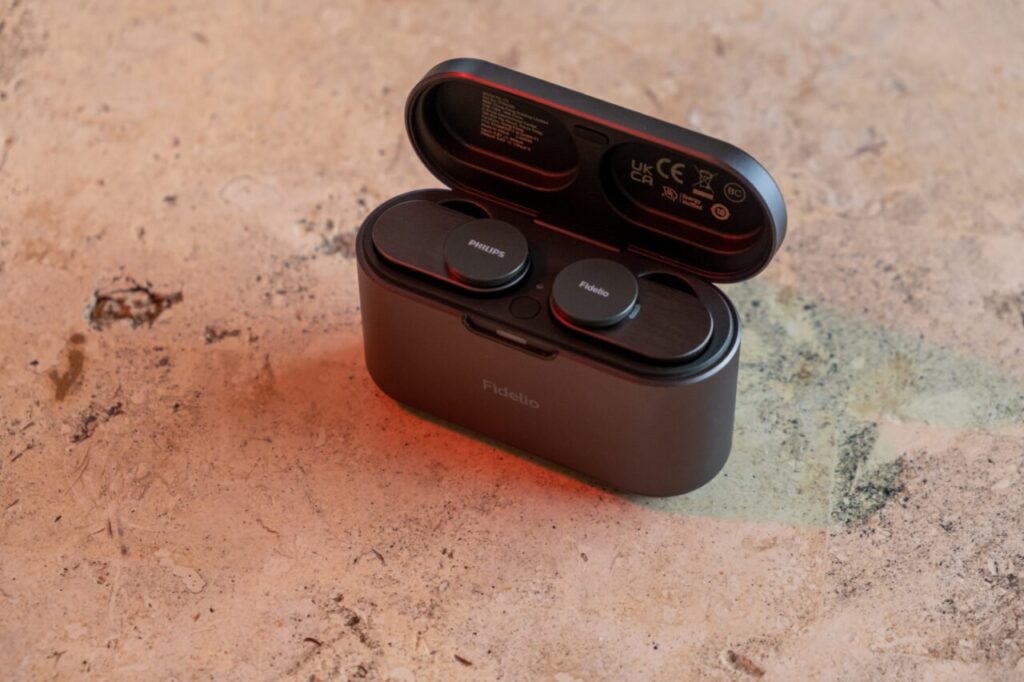
LDAC is a fairly unstable codec by nature. It must transmit a very high bitrate, which can often result in signal termination or artifacts. In the case of the reviewed Philips Fidelio T1 TWS headphones, I have not experienced this problem even once . Well, once through the application, the left earbud stopped working for a while, but it was enough to put it in the box and take it out after a while.
In addition, the headphones always connect almost immediately after removing them from the case, and the connection itself is maintained without any problems, even in unfavorable conditions, or a fairly large distance from the phone. The only problem is a fairly large delay, which does not attract attention in movies, so in the case of games it is already visible and annoying.
The sound quality is more than satisfactory
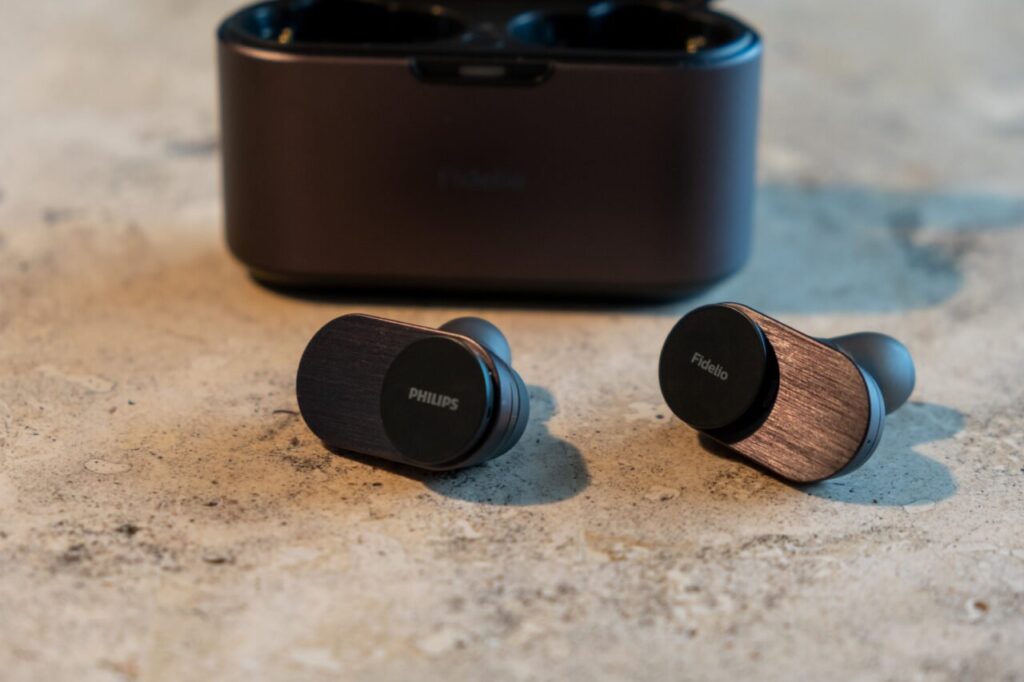
In the description I can use phrases that do not have to be fully legible. I invite you to the ranking and the guide on what headphones to buy , where I tried to explain many of them.
Philips Fidelio T1 puts on quite entertaining and very dynamic sound, but they do not exaggerate with anything. It is a delicate V with receding vocals, but the bass definitely does not impose itself on the midrange. What I am very happy about is that the headphones do not have an excessive amount of mid base, and there is more sub bass , which is really very good quality. Thanks to this, the music does not give the impression of silting, and is very effective.
The diameter is highly textured
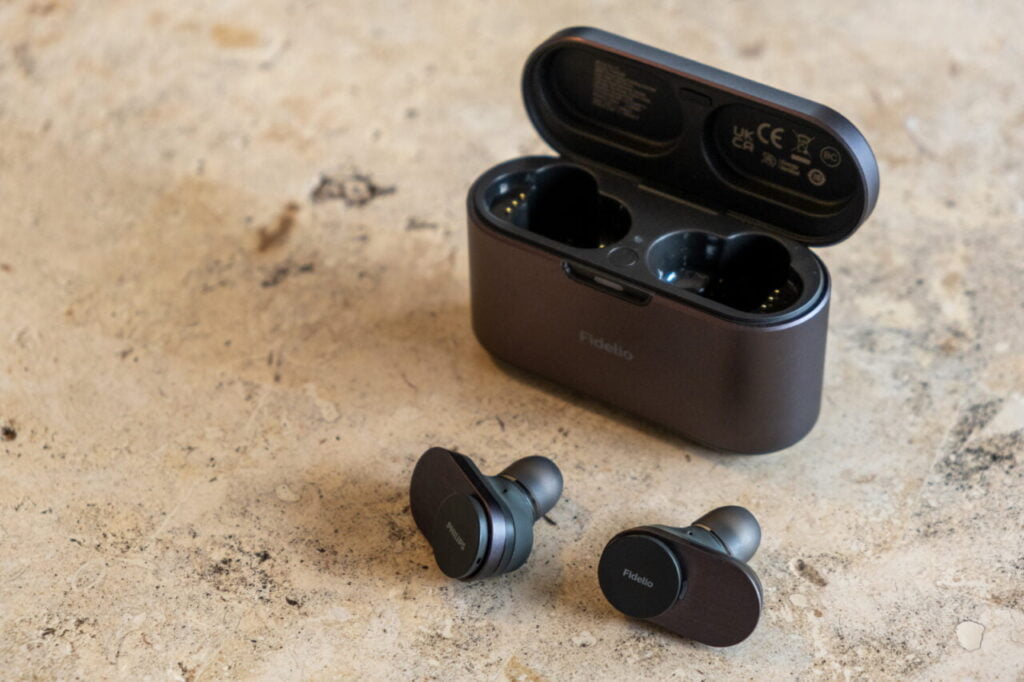
The midrange includes, among others, vocals and guitars, which benefit a lot from the texture. You can perfectly hear the delicate hoarseness of many singers, or specific strokes on the strings. To some, such a sound may seem slightly dry, but it is enough to listen carefully to understand the texture, combined with a natural, though slightly receding center. If we want the vocals to be in the first place, it is enough to switch the equalizer to “Voice” in the application. It pushes and smoothes the midrange, while gently withdrawing the bass. The sound becomes a bit more nasal then, but the midrange comes out a lot to the front.
For some people the treble may be slightly painful
Although it shouldn’t be, it is already a matter of habit. I myself have recently used more headphones with a substantial treble, which made the Philips Fidelio T1 not impressed me. Two days with more bass models, however, already showed that in the lower parts of the treble you may notice a slight hiss and some sibilants with medium recorded tracks. With good quality recordings, I did not feel it myself, but people who are more sensitive to the highest tones may not be satisfied.
Surprisingly wide stage and very good separation
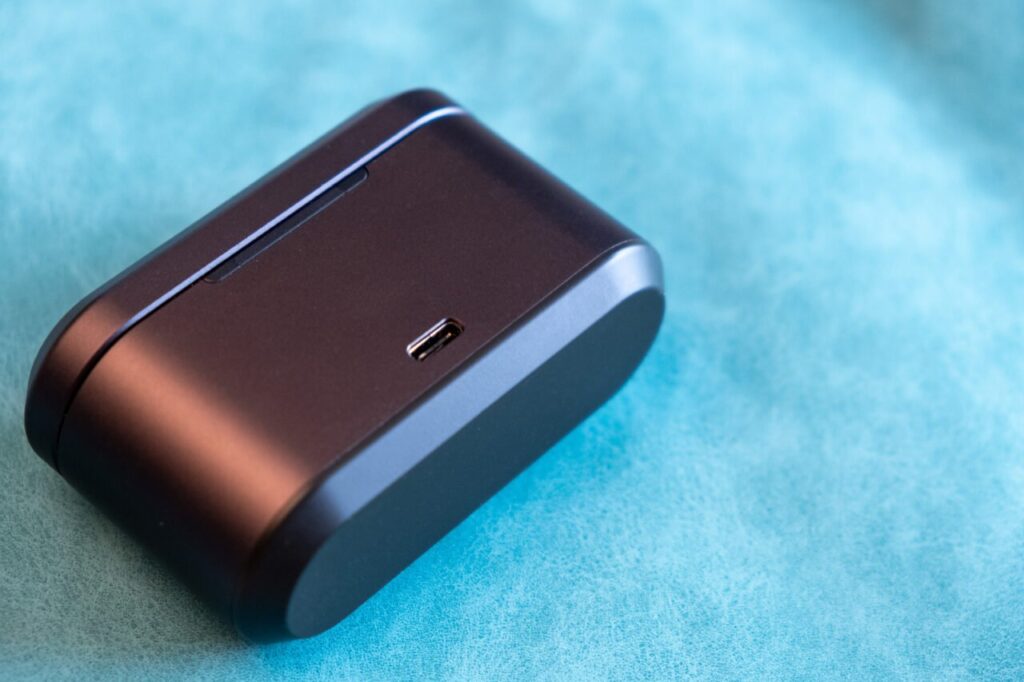
These two elements surprised me especially when reviewing the Philips Fidelio T1 headphones. Many TWS models just play right-left-center, and here you can hear a much wider range of spaces. The headphones present a very good depth and the stage is well developed in terms of both width and length. Separation is another very positive aspect, because even very large realizations do not blend into a whole and allow you to capture specific instruments.
The app is there, but it’s missing a lot
With the help of the Philips Headphones app, we can control our Philips Fidelio T1 and change a few small things, but due to the quality of the translation, you often have to guess what a given function means.
In the application, we have a choice of four sound modes, the ability to turn off the music pause function when removing the headphones, enable LDAC with it (before starting the application, it is the default codec for connecting to the phone) , or we can update the headphones. In the long run, only the last function is very important. If Philips decides to develop the application, add an equalizer to it, or the ability to change gestures, the headphones will definitely gain in the eyes of many people.
The battery keeps almost as the manufacturer announces
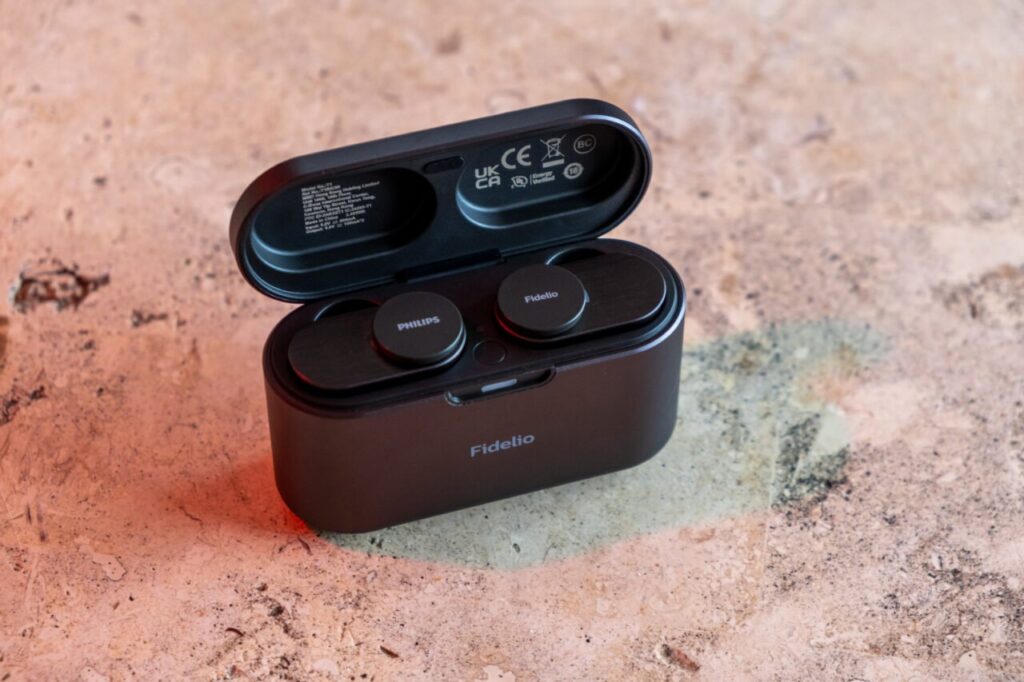
The best time I was able to get on a single charge of the headphones was around seven hours with ANC on and volume around 70% . This is less than two hours compared to what Philips gives for the Fidelio T1 model. This is not a bad result, because it is very good, but it is still below the manufacturer’s specifications. However, they did not specify at what volume it is achievable, so if we listen very quietly, a battery life of 9 hours is possible. But let’s face it, who can stand so much in the headphones and not even throw them into the case for a moment?
Philips Fidelio T1 review – summary
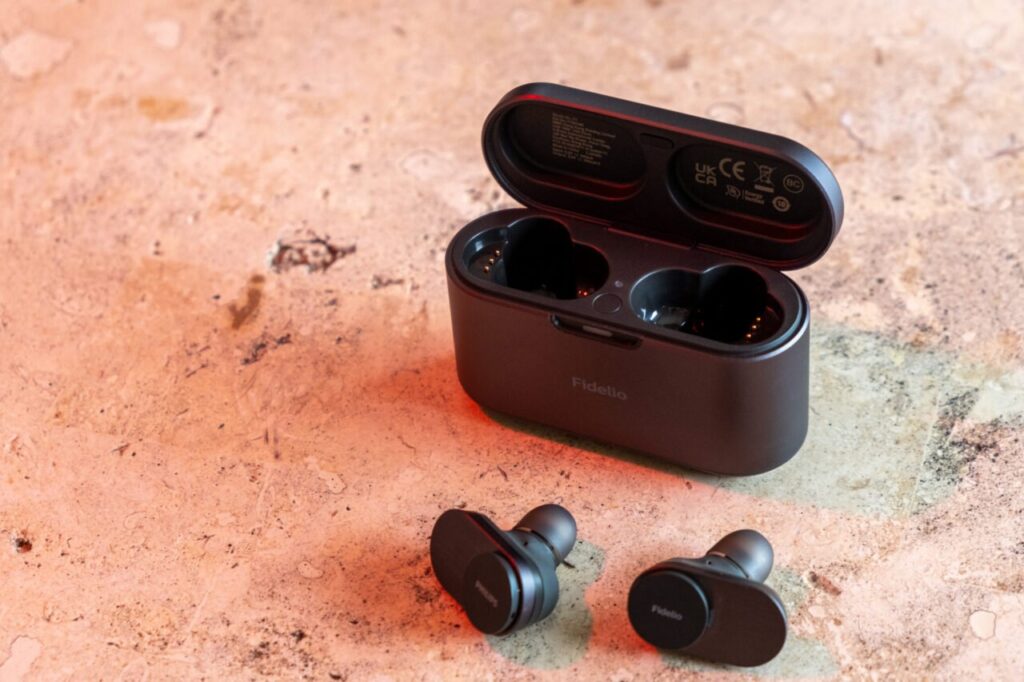
I definitely like the Philips Fidelio T1 in terms of sound. You can also see the manufacturer’s principle that sound and build quality are above all. Well, maybe apart from that wretched hinge in the charging case which should be better. The manufacturer also provided us with a very good connection quality, a great battery, and also a really good ANC. The only elements that clearly require refinement are ergonomics and the application. While the first element is simply average, the second one gives the impression that it does not exist in relation to competitors, such as the Soundcore Liberty 3 Pro .

